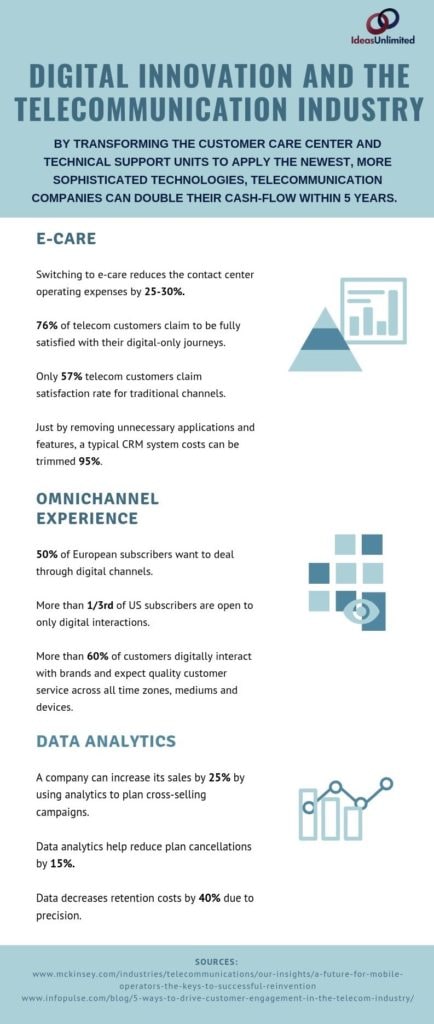Here is an important question for you: Why do firms run businesses?
The most common answer is: To generate profits and achieve a sustainable position in the market.
The telecommunication industry has been trying to replicate this capital-intensive industry synergy, but without moving beyond the orthodox consumer models. Therefore, with partial redundancy of voice and texting plans, telecom companies have been trying hard to balance their ROI and declining cashflows. Currently, Western European and North American Telecom is also selling broadband, TV, media services, and data services to manage profitability and capital returns. It is, however, more important to note that the landscape has been greatly transformed because Facebook, Google, Netflix, and other data-driven companies have taken it very far from the typical telecom market by creating new forms of communication, technical support, and viewer choices.
Now let me ask you my question again: Why do firms run businesses?
This time a Million Dollar Answer should be: To maintain their competitive edge, evolve with time, and create positive customer experiences for profitability and sustainability.
Digital innovation can help telecommunication companies streamline operational processes, satisfy customers, reduce costs, and increase sales.
As the telecommunication companies have waited too long to understand and respond to this digital disruption, digital companies like Facebook and Netflix have jumped in and established themselves as the fiercest competitors to the telecommunication industry. These data-driven giants have grabbed a major share of the customer satisfaction pie—the main ingredient of success in today’s world. And to catch up, the telecommunication industry has to free up resources and employ trained, tech-savvy teams to support their customer care center and technical customer support units.
Customer focus is the main target. Telecommunications companies differentiate themselves and achieve success through customer-centric models. This requires drastic changes in operational, technological, and organizational processes.
E-Care
It is time for the telecommunication industry to step up their technical customer support to win big on customer experience and satisfaction. Providing technical customer support through digital channels is reported to increase customer satisfaction significantly.
Deloitte reviews how technical customer support teams can create differentiation and give businesses a competitive edge to retain and acquire customers. Giffgaff, a UK virtual network operator, has set a precedent in E-care or digital technical customer support. With just 33 employees, Giffgaff has a record of clearing customer queries/issues within three minutes. It has succeeded in building a community of users who help each other digitally and even developed Nokia and iOS applications through discussions and mutual help.
This demonstrates an excellent example of E-care, which also results in high levels of customer engagement and satisfaction. Digitization makes support services leaner, quicker, and effective. This reduces costs and capital commitment for the company.
The telecommunication industry hardly fares well when customer service metrics are compared. It has failed to fully appreciate the potential of developing digital technical customer support for tier one and two. As the market moves faster towards more sophisticated technologies and cloud-based systems and products and services, it is necessary to avoid communication delays and ineffective solutions.

Generation Y and Generation Z are tech savvy, have lesser time, and prefer online communication. Therefore, systems like E-care can accommodate and elevate their overall customer experience with a telecom operator.
Reports by McKinsey have shown that E-care also reduces customer care center costs by 25-30% while online technical customer support improves customer experience by 76%. Another mobile operator reduced the number of support service calls by 90% by introducing sophisticated systems for E-care. This shows the significance of building and facilitating digital-only journeys for modern telecom users. A three-tiered system of technical support with advanced systems can easily navigate and anticipate problems and issue resources to the customers as required.
Omnichannel Experience

When digital services become extensive, they necessitate the introduction of a cohesive online/offline operations model for your business to deliver a consistent experience across all channels of communication and customer contact points. Your customer care center should be able to keep up with the evolving demands and preferences of your customers. Each touchpoint, whether operated digitally or through a customer representative, needs to deliver an expected level of service.
More than 60% of customers digitally interact with brands and request their services through different mediums. They expect consistent and quality customer service across all time zones, mediums, and devices. Unified cross-channel services will bring loyalty and repeated sales for the company.
A well-managed omnichannel customer experience means a well-integrated and seamless experience for the consumers through which they can resolve service issues and communicate with the company. Different customers can have different communication preferences and the omnichannel support model enables them to choose different channels alternatively, simultaneously, and in combination, to build their own digital journeys.
Developing the omnichannel experience for your customers will also result in a wealth of customer data, which can further help to elevate customer service at multiple touch points by better personalization and service access. Big data and predictive analyses give a unified view of customers that is required for the omnichannel experience.
IdeasUnlimited has been assisting a number of companies in the telecommunication industry meet these contemporary challenges. If you are interested in knowing more about our services for telephone companies, internet service providers, wireless telecommunication carriers, network service providers, and media service providers, click here ->
Harnessing Big Data and Predictive Analysis
Communication companies have access to much more data than any other companies. And in most instances, this data passes from the telecommunications companies to the data companies.
The need is to use it effectively in order to gain an insight into customer behavior and usage patterns. Data can help in developing a personalized customer care system that enhances your customers’ experiences.
- Using predictive analysis can help companies in creating better cross-channel targeted marketing campaigns.
- It can aid in customer profitability analysis and evaluation of the most effective touchpoint: the one with highest ROI.
- It can help in building relationships for higher customer lifetime value.
- It can be used to develop precise outreach and incentive packages for high maintenance and price sensitive customer groups.
- Such offers then can be replicated according to customer profiles or can be widely extended to target many segments.
- Cross-selling campaigns and efforts are more effective (25%) to retain customers when backed by predictive models.
- All the analytics can help give a fresh perspective of what the consumer needs and how your business can provide it.
- Data-sharing partnership is also a potential avenue for increasing customer retention by letting partner companies access your subscribers’ data and then offer your customers time and location-specific offers.
Digital innovation is no magic but it can surely do wonders for a business if it is used proactively and consistently. A set formula does not exist, each company must rely on internal as well as external resources to build and maintain proactive momentum. Customer satisfaction and performance matters for the capital-intensive telecommunications industry. Therefore, to adapt to the transformed structures of consumer demands and market competition, telecommunication companies must reinvent digital capabilities.










What is E-Care?
Please tell me in simple words.
In a nutshell, eCare refers to receiving customer support digitally via digital channels such as websites, apps, email, chat, and social media. It’s all about interacting with and assisting clients through the use of technology. As an example: You’ve probably come across FAQs, user manuals, video tutorials, or knowledge bases on many internet platforms such as Gmail.
Other examples might include:
– Live Chat
– Email Support
– Social Media Engagement
– Text Messaging
– Mobile Apps
– Virtual Assistants and Chatbots